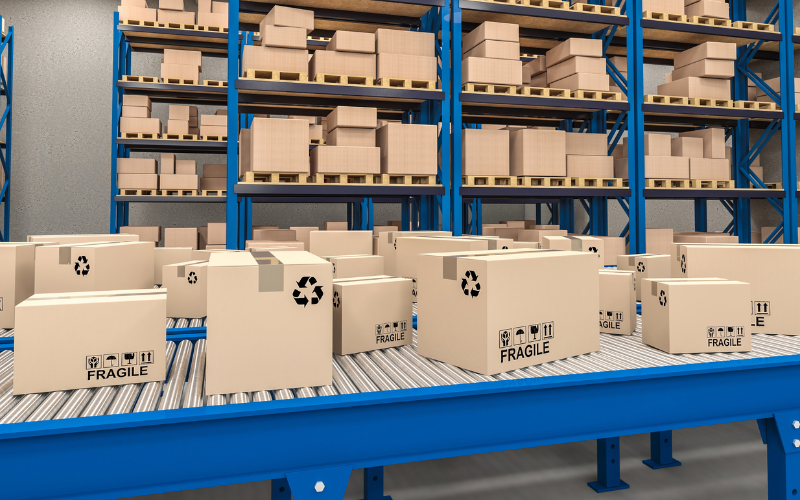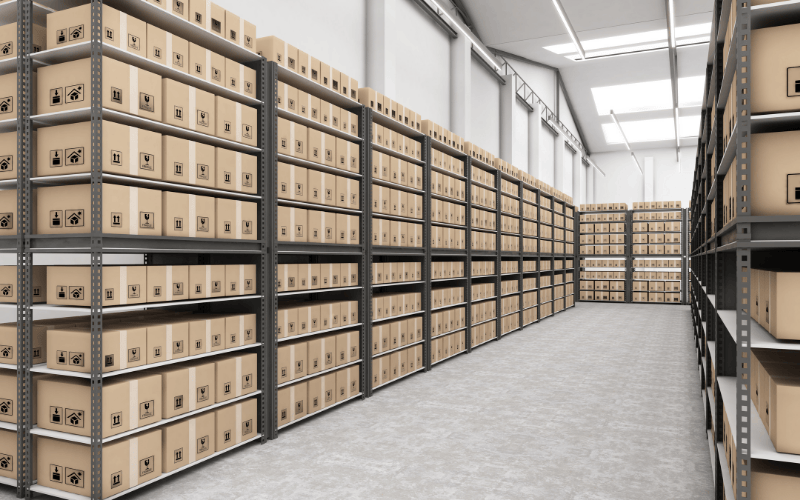Optimize your business: use unlimited savings with Pazago fulfilled now!
Get Started ->Warehousing powers today's commerce. It keeps inventory balanced, cuts costs, and speeds up order delivery. With e-commerce booming and supply chains getting more complex, efficient warehousing is essential. From manufacturers to online stores, smart warehousing helps businesses meet customer demands, manage expenses, and stay competitive.
The global warehouse market will reach $1.73 trillion by 2030, growing 8.1% annually due to rising e-commerce, technology, and supply chain demands. This shift emphasizes the critical role that modern warehousing plays in supporting global supply chains.
This article explores the essential aspects of warehousing, from its fundamental role in supply chain management to its core functions, key processes, and technological advancements.
What Is Warehousing?
Warehousing involves storing, managing, and handling goods in facilities designed for large inventories. These centers keep products secure, organized, and accessible for distribution or sale.
A well-run warehouse protects inventory from damage and theft and supports efficient order fulfillment. Key tasks include receiving shipments, storing products, tracking inventory, and preparing orders for dispatch.
Modern warehouses use technologies like automated storage systems, barcode scanning, and inventory software to boost efficiency. Maximizing space and readiness, they help businesses meet customer demand and keep supply chains running smoothly.
Whether storing raw materials, finished goods, or retail stock, warehousing ensures a steady flow of products while reducing logistical issues.
Core Functions of Warehousing

Effective warehousing encompasses a wide range of critical functions that are vital for maintaining a smooth and efficient supply chain. These functions not only ensure that products move smoothly from suppliers to customers but also help businesses reduce costs, minimize errors, and improve overall operational efficiency.
By fulfilling these roles effectively, warehouses play a pivotal role in enhancing customer satisfaction and supporting business growth. The key functions that make warehousing a cornerstone of supply chain management include:
- Inventory Management
Real-time tracking systems like barcodes, RFID, and WMS help maintain accurate stock levels, reduce carrying costs, and prevent stockouts or overstocking. Regular audits and demand planning further improve forecasting and control.
- Order Fulfillment
Efficient picking, packing, and shipping systems, supported by automation and digital tools, speed up processing and improve accuracy. Quality checks and order tracking enhance customer satisfaction.
- Product Protection
Warehouses use secure storage, climate control, and safety protocols to protect goods from damage, theft, or environmental hazards. Risk management includes surveillance, staff training, and compliance with safety standards.
- Space Optimization
Strategic layout, vertical storage, and slotting techniques maximize capacity and improve workflow. Automated systems and real-time space analysis further enhance utilization without expanding the footprint.
- Value-Added Services
Services like kitting, labeling, and custom packaging increase supply chain flexibility and product readiness. These offerings improve branding, simplify order processing, and reduce lead times.
- Inbound and Outbound Logistics
Accurate receiving and timely shipping processes ensure inventory accuracy and fast deliveries. This includes route optimization, shipment tracking, and carrier coordination.
- Returns Management (Reverse Logistics)
Returned items are inspected, restocked, or refurbished to recover value and minimize waste. Efficient systems also support warranties and improve customer experience.
- Demand Forecasting and Planning
Predictive tools and historical data help align inventory with market demand. Advanced forecasting reduces stock imbalances and optimizes purchasing.
- Warehouse Safety and Compliance
Regular training, audits, and safety systems protect workers and goods. IoT sensors and automated alerts enhance real-time monitoring and regulatory compliance.
- Performance Monitoring and Reporting
KPIs like order accuracy and pick rates reveal process gaps and guide improvements. Dashboards and analytics tools support data-driven decision-making.
Also Read: Understanding How a Logistics System Works and Its Main Components
8 Elements of Warehousing
Warehousing involves several key elements that work together to ensure efficient storage, management, and movement of goods. These components help maintain inventory accuracy, protect products, and streamline order fulfillment. Here are the essential elements of warehousing:
- Storage Space: Dedicated areas to hold inventory safely and efficiently.
- Receiving: The Process of accepting and inspecting incoming goods.
- Inventory Management: Tracking stock levels and locations accurately.
- Order Processing: Picking, packing, and preparing goods for shipment.
- Security: Measures to protect inventory from theft and damage.
- Material Handling Equipment: Tools such as forklifts and conveyors to move goods.
- Technology: Systems such as barcode scanners and warehouse management software.
- Transportation Access: Facilities for smooth loading and unloading of shipments.
Also Read: How Logistics Operations and Supply Chain Works
Importance of Warehousing in Supply Chain Management

Warehousing plays a pivotal role in supply chain management by bridging the gap between production and consumption. Its significance spans multiple facets that together improve operational efficiency, cost management, and customer satisfaction.
- Balancing Supply and Demand: Warehouses hold inventory to meet fluctuating customer demand, preventing stockouts and lost sales even during supply chain disruptions.
- Reducing Lead Times: Strategically located warehouses speed up deliveries by storing products closer to customers, improving responsiveness and competitive advantage.
- Lowering Transportation Costs: Warehousing enables bulk shipments to central locations and smaller local deliveries, cutting shipping expenses and optimizing routes.
- Supporting Production and Inventory Control: Warehouses buffer production from demand changes and use technology like barcode scanning and WMS for accurate stock management.
- Enhancing Customer Satisfaction and Supply Chain Visibility: Efficient warehousing ensures timely orders, builds trust, and provides critical data for better coordination across the supply chain.
10 Common Types of Warehouses
Businesses select warehouse types based on their operational needs, product types, and distribution strategies. Each warehouse type offers distinct advantages, customized to specific logistical demands. Below are the primary warehouse categories and key considerations:
- Distribution Centers: Distribution centers handle high volumes of goods with a focus on fast processing and outbound shipping. They receive products from suppliers, sort and package them, and then quickly dispatch orders to retailers or customers.
- Fulfillment Centers: Fulfillment centers specialize in processing e-commerce orders. Their priority is rapid, accurate picking, packing, and shipping of individual orders. Integration with online sales platforms and automation technology ensures minimal errors and quick delivery, meeting modern consumer expectations.
- Cold Storage Warehouses: Cold storage warehouses maintain temperature-controlled environments for perishable goods such as food, pharmaceuticals, and chemicals. Using refrigeration and freezing systems, these warehouses prevent spoilage and extend shelf life. To meet regulatory standards, they require specialized infrastructure and continuous climate monitoring.
- Bonded Warehouses: Bonded warehouses securely store imported goods awaiting customs clearance. These facilities allow businesses to delay paying import duties until products leave the warehouse for domestic use.
- Smart Warehouses: Smart warehouses utilize automation, robotics, IoT sensors, and data analytics to optimize inventory management and operational efficiency. They enable real-time monitoring, predictive maintenance, and rapid adaptation to demand fluctuations, reducing errors and labor costs.
- Public Warehouses: Public warehouses offer storage space and related services to multiple businesses on a rental basis. They provide flexibility for companies without long-term storage needs or capital to invest in their own facilities.
- Private Warehouses: Private warehouses are owned and operated by a single company for exclusive use. They provide full control over storage and handling processes but require significant investment and operational expertise.
- Cross-Docking Facilities: Cross-docking facilities minimize storage time by quickly transferring goods from inbound to outbound transportation. Products move directly through the warehouse, reducing inventory holding costs and speeding up delivery. This setup suits fast-moving items and just-in-time supply chains.
- Hazardous Material Warehouses: These specialized warehouses store hazardous goods under strict safety and environmental regulations. Features include containment systems, ventilation, and enhanced security to prevent accidents and contamination.
- Automated Storage and Retrieval Systems (AS/RS) Warehouses: AS/RS warehouses employ robotics and conveyor systems for automatic storage and retrieval. They maximize space utilization, reduce labor costs, and improve accuracy and speed in inventory handling.
Suggested Read: How to Implement Inventory Tracking: Steps and Methods
Technological Advancements in Warehousing

Modern warehouses increasingly depend on cutting-edge technologies to streamline operations, improve accuracy, and reduce costs. These innovations turn traditional storage spaces into advanced distribution centers capable of supporting complex supply chains and rapid delivery demands. Key technological advancements include:
- Automated Storage and Retrieval Systems (AS/RS): AS/RS use robotics to automatically store and retrieve goods, increasing speed, reducing errors, and maximizing vertical space.
- Warehouse Management Systems (WMS): WMS software oversees inventory, order processing, and labor in real time, optimizing workflows and providing data-driven insights.
- Robotics and Automation: Robots handle repetitive tasks like picking and packing, boosting productivity, reducing labor costs, and improving workplace safety.
- Space Optimization Technologies: Smart systems analyze inventory movement to maximize storage density and reduce travel time within the warehouse.
- Internet of Things (IoT): IoT devices track inventory conditions and equipment performance in real time, helping prevent damage and maintain product quality.
- Artificial Intelligence (AI) and Machine Learning: AI predicts demand, optimizes picking routes, and continuously improves operations through real-time data analysis.
- Drones and Aerial Inventory Management: Drones perform fast, accurate inventory counts in large or hard-to-reach areas, reducing audit time and labor costs.
- Augmented Reality (AR) for Workforce Assistance: AR guides workers through tasks with real-time visual cues, reducing training time and picking errors.
- Blockchain for Supply Chain Transparency: Blockchain records every transaction securely, improving traceability, preventing fraud, and streamlining audits.
- Energy-Efficient Technologies: Smart energy systems cut costs and emissions by optimizing lighting, temperature, and ventilation based on real-time usage.
Conclusion
Effective product warehousing is key to supply chain success. It provides secure storage, streamlines fulfillment, cuts costs, and ensures accurate, fast order processing, all crucial for customer satisfaction and growth.
Looking ahead, warehousing will lean heavily on automation, data, and sustainability. Technologies like robotics, AI, and real-time analytics will boost efficiency, reduce errors, and enhance supply chain visibility.
Pazago supports this shift by offering centralized inventory management, real-time tracking, and simplified order fulfillment processes. With features designed to enhance visibility and control, Pazago helps businesses optimize their warehousing operations, reduce costs, and stay competitive in an increasingly complex market.
Curious about how smarter warehousing can benefit your business? Explore how Pazago can simplify your operations and drive long-term success. Book a demo with us today.
FAQs
Q. How does warehousing impact customer satisfaction?
A. Warehousing directly impacts customer satisfaction by ensuring faster order processing, accurate deliveries, and reliable stock availability. Efficient warehousing reduces delays and errors, enhancing the overall customer experience.
Q. How can technology improve warehousing operations?
A. Technology like warehouse management systems (WMS), automated storage and retrieval systems (ASRS), robotics, and real-time inventory tracking can improve accuracy, reduce operational costs, and increase overall efficiency.
Q. What role do third-party logistics (3PL) providers play in warehousing?
A. 3PL providers offer outsourced warehousing and logistics services, allowing businesses to scale quickly without significant capital investment in physical infrastructure. They provide services like inventory management, order fulfillment, and reverse logistics.


.png)








